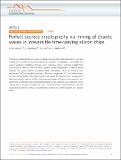Files in this item
Perfect secrecy cryptography via mixing of chaotic waves in irreversible time-varying silicon chips
Item metadata
| dc.contributor.author | Di Falco, Andrea | |
| dc.contributor.author | Mazzone, V | |
| dc.contributor.author | Cruz, A | |
| dc.contributor.author | Fratalocchi, A | |
| dc.date.accessioned | 2019-12-20T12:30:06Z | |
| dc.date.available | 2019-12-20T12:30:06Z | |
| dc.date.issued | 2019-12-20 | |
| dc.identifier | 263520537 | |
| dc.identifier | 52ea5ad4-97c9-4c1c-a7df-51373471fb9f | |
| dc.identifier | 85076882176 | |
| dc.identifier | 000509780300031 | |
| dc.identifier.citation | Di Falco , A , Mazzone , V , Cruz , A & Fratalocchi , A 2019 , ' Perfect secrecy cryptography via mixing of chaotic waves in irreversible time-varying silicon chips ' , Nature Communications , vol. 10 , 5827 . https://doi.org/10.1038/s41467-019-13740-y | en |
| dc.identifier.issn | 2041-1723 | |
| dc.identifier.other | ORCID: /0000-0002-7338-8785/work/66398341 | |
| dc.identifier.uri | https://hdl.handle.net/10023/19179 | |
| dc.description | A.D.F. acknowledges support from EPSRC (EP/L017008/1). A.F. acknowledges support from KAUST (OSR-2016-CRG5-2995). The research data underpinning this publication can be accessed at https://doi.org/10.17630/19156fc3-cc1f-4ee3-b553-f02042cf89a0. | en |
| dc.description.abstract | Protecting confidential data is a major worldwide challenge. Classical cryptography is fast and scalable, but its broken by quantum algorithms. Quantum cryptography is unclonable, but requires quantum installations that are more expensive, slower, and less scalable than classical optical networks. Here we show a perfect secrecy cryptography in classical optical channels. The system exploits correlated chaotic wavepackets, which are mixed in inexpensive and CMOS compatible silicon chips. The chips can generate 0:1 Tbit of different keys for every mm of length of the input channel, and require the transmission of an amount of data that can be as small as 1/1000 of the message’s length. We discuss the security of this protocol for an attacker with unlimited technological power, and who can access the system copying any of its part, including the chips. The second law of thermodynamics and the exponential sensitivity of chaos unconditionally protect this scheme against any possible attack. | |
| dc.format.extent | 10 | |
| dc.format.extent | 2222541 | |
| dc.language.iso | eng | |
| dc.relation.ispartof | Nature Communications | en |
| dc.subject | QA75 Electronic computers. Computer science | en |
| dc.subject | QC Physics | en |
| dc.subject | TK Electrical engineering. Electronics Nuclear engineering | en |
| dc.subject | DAS | en |
| dc.subject | BDC | en |
| dc.subject | R2C | en |
| dc.subject.lcc | QA75 | en |
| dc.subject.lcc | QC | en |
| dc.subject.lcc | TK | en |
| dc.title | Perfect secrecy cryptography via mixing of chaotic waves in irreversible time-varying silicon chips | en |
| dc.type | Journal article | en |
| dc.contributor.sponsor | EPSRC | en |
| dc.contributor.institution | University of St Andrews. Centre for Biophotonics | en |
| dc.contributor.institution | University of St Andrews. School of Physics and Astronomy | en |
| dc.identifier.doi | 10.1038/s41467-019-13740-y | |
| dc.description.status | Peer reviewed | en |
| dc.identifier.grantnumber | ep/l017008/1 | en |
This item appears in the following Collection(s)
Items in the St Andrews Research Repository are protected by copyright, with all rights reserved, unless otherwise indicated.

